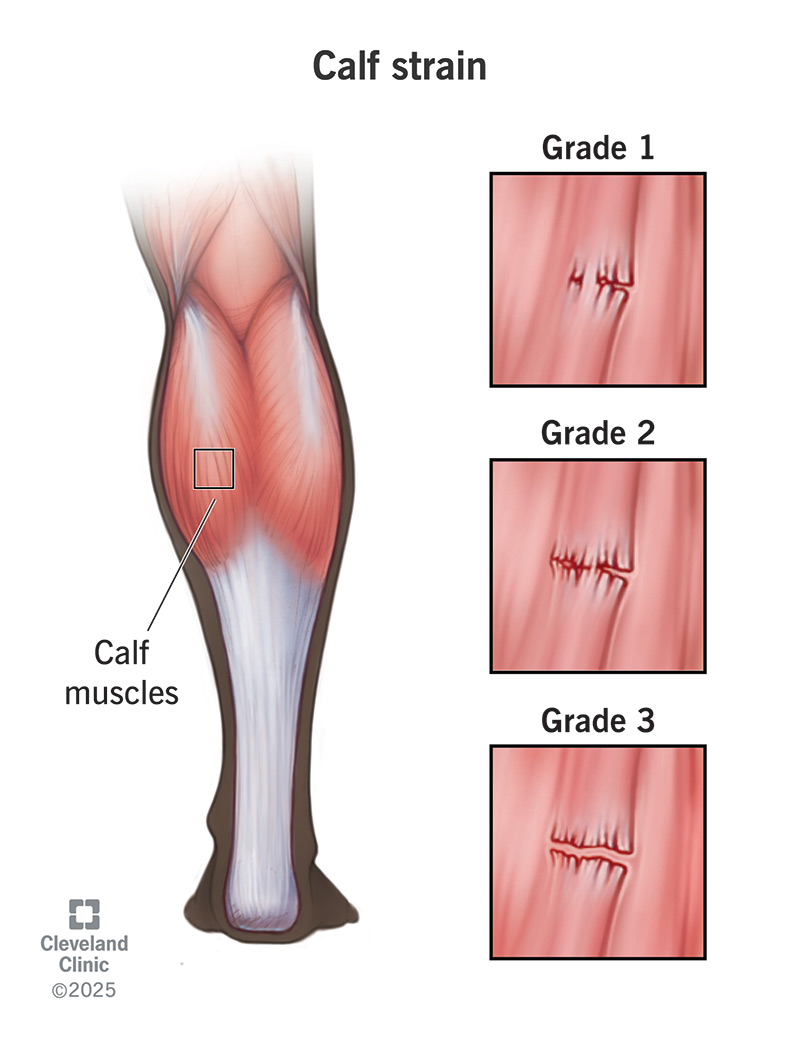A calf strain occurs when you overstretch the muscles in the back of your lower leg. Also called a pulled calf muscle, this injury can range from mild to severe. Treatment for mild injuries typically involves rest, ice, compression and elevation. Severe injuries may require additional treatment from a healthcare provider.
Advertisement
Cleveland Clinic is a non-profit academic medical center. Advertising on our site helps support our mission. We do not endorse non-Cleveland Clinic products or services. Policy

A calf strain, or pulled calf muscle, occurs when you overstretch a muscle in your calf. Your calf muscles are in your lower leg behind your shin bone (tibia) and extend from the base of your thigh down to your heel. They help you flex and bend your foot, ankle and knee. A strained calf muscle can cause pain and prevent you from running, jumping and doing other activities.
Advertisement
Cleveland Clinic is a non-profit academic medical center. Advertising on our site helps support our mission. We do not endorse non-Cleveland Clinic products or services. Policy
Most calf injuries are mild, but a severe calf strain can result in a partially or completely torn calf muscle. Whether you have a mild or severe injury, you should see a healthcare provider as soon as possible. Early diagnosis and treatment will get you back to participating in the sports and activities you love sooner.
Calf strain symptoms may include:
Most people with a strained calf muscle say they can’t continue with their activity immediately following an injury.
Calf strains usually occur when someone suddenly moves or overstretches their calf after standing still. Quick pivots, jumps or abrupt stops can cause strains. This injury is especially common when your toes get forced upward (toward your body) and your ankle pulls your calf muscles down too quickly.
Anyone can get a pulled calf muscle. But these strains are more common in athletes who perform lots of stop-and-go movements with quick bursts of speed. Sprinters, football players, soccer players and tennis players are prone to strained calf muscles. Sometimes, the injury is called “tennis leg.”
Advertisement
Other risk factors for calf strains include:
Depending on the severity of your condition, complications of a pulled calf muscle may include:
A healthcare provider will perform a physical exam and review your symptoms. It’s important to describe in detail how you got the injury and how your calf felt immediately after the injury. This information can help your healthcare provider make a diagnosis.
You may need imaging exams to rule out other conditions that cause lower leg pain, like Achilles tendon ruptures or deep vein thrombosis (DVT). Research shows that up to 10% of people with symptoms of calf pulls have DVT, which can be a life-threatening condition.
Your healthcare provider may request the following tests:
Pulled calf muscle treatment usually includes RICE, which stands for:
You can perform RICE at home, but it’s always good to check in with your healthcare provider about any special instructions.
Once your provider diagnoses your injury, they may recommend additional calf strain treatment, including:
While healing from a calf strain, you should avoid:
Most people recover fully from pulled calf muscles without any permanent damage. Ask your healthcare provider when you can gradually start to do light activities again. Depending on the severity of your injury, it may be several weeks or even months before you can return to full activities.
Advertisement
Once you’ve had a calf muscle strain, you have a higher risk for future strains in that area. Reduce your risk of reinjury by allowing your injury to fully heal before getting back to normal activities.
You should contact your provider if you:
You can reduce your risk of a pulled calf muscle by:
Playing sports that require lots of quick movements can come with a risk of injury. Calf strains (pulled calf muscle) are one of the most common injuries that affect athletes. But anyone can pull a calf muscle. If you do, you’ll probably experience pain, swelling, and trouble bending and flexing your foot, ankle or knee. Don’t wait to get treatment. While you can probably treat a mild sprain with the RICE method, a trip to a healthcare provider’s office can ensure that you’re on your way to getting back on your feet sooner rather than later.
Advertisement
From sudden injuries to chronic conditions, Cleveland Clinic’s orthopaedic providers can guide you through testing, treatment and beyond.

Last reviewed on 04/03/2025.
Learn more about the Health Library and our editorial process.